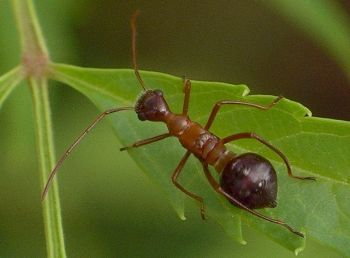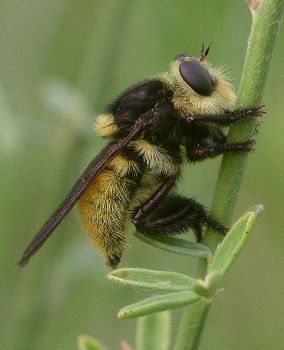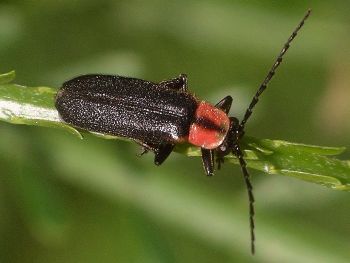
The nymph of the Texas bow-legged bug looks remarkably like an ant.
 The nymph of the Texas bow-legged bug looks remarkably like an ant. |
Many insects simply use camouflage. They might blend in with rocks, leaves, lichens, or tree bark. This passive mimicry must be very effective because it is quite common. It also makes it hard to see examples - the naturalist looking for these animals must develop an eye for finding things that have no intention of being found. One of my favorites in this category is a group of caterpillars (in the family of moths called prominents) that chew off one side of a leaf while resembling the missing part. It is always a delight and challenge to find these odd-looking little critters.
Animals that mimic something more dangerous often act the part as well as look it. There are numerous flower flies in the family Syrphidae that resemble wasps and bees simply because they are less likely to be eaten if they look like these better defended creatures. Wasps have a particular way of feeding at flowers. They tend to walk around on the blossoms as much as possible, saving the energy it would take to fly. Bees, however, flit quickly from one bloom to another. Flies are already genetically equipped to vaguely resemble bees or wasps. They have wings, body shapes that are similar, and are about the same size. They also tend to feed at flowers, just like bees and wasps.
 This robber fly closely resembles its bee prey. |
Numerous flies look amazingly like bees. There is even a whole fly family called Bee Flies. The hover flies have some of the best costumes though. It is interesting to note too that some flies will mimic the movements of bees, which sometimes involve little circular flight patterns between flowers, a quick darting motion, or hovering. It takes practice on the part of the observer to recognize which are really bees and which are flies.
Large flies are not well suited to flying quickly from flower to flower, so they do better to look like the slower moving wasps. The most amazing flower fly that I've seen looks just like a queen yellow jacket. It is rather big and has the same colors. It walks about on the flowers just as a wasp would. What the fly is missing, though, are the long antennae found on wasps. A solution has even developed for this problem. When confronted, the fly will face the threat and move its front two legs, which are appropriately colored black instead of yellow, like the other legs, just as if they were antennae at the front of its head. Quite a show.
Predatory robber flies make double use of their fly/wasp costumes: they not only fool their own attackers but also their prey, which doesn't perceive a fellow bee as a possible threat.
Flies are not the only masters of disguise. Any wee beast that does not have stinging spines, toxins in its body, or strong jaws with which to bite an assailant is a candidate for mimicking something that does possess these assets. The number of cross-dressing insects and spiders is amazing. Some beetles and true bugs have thick antennae that look and move just like the front legs of spiders. Some spiders mimic ants (which have good defenses) and beetles (which have strong armor).
Just as bees and wasps are often the model for mimics, their close relatives, ants, also have their share of imitators. Ants, with the safety of numbers, body toxins, stings, and strong jaws, have many masqueraders that look like them. Anything that is small and has at least a close body shape is a candidate. Spiders are not the only copycats using the ant model. Beetles, true bugs, and even flies sometimes look amazingly like them as well.
 A palatable soldier beetle has the same colors as a distasteful firefly. |
There are also various insects that simply have large "eye" spots that can startle or fool a predator long enough to allow for escape. Sometimes the fake eyes, such as those on caterpillars, resemble a snake. Other times, the spots are more generalized, such as found on butterflies' wings. Another tactic is to have markings or structures on the rear that look like the head, so that an attack comes at the wrong end. Caterpillars are made for this trick, but it also occurs on beetles (especially those that feed head-first in flowers) and butterflies (the little tail structures on hairstreaks). An insect called an owlfly has a pair of black dots on the tip of its abdomen and, when threatened, it will raise its long body up so that the "eyes" point upwards to confront the intruder.
While the lives of insects and spiders are not as spectacular in absolute terms as, say, those of zebras and wolves, the life and death struggles at the micro level are certainly easier to observe and far more diverse. It only takes a bit of practice and persistence to get a glimpse of the fascinating activities surrounding us in our own backyards.